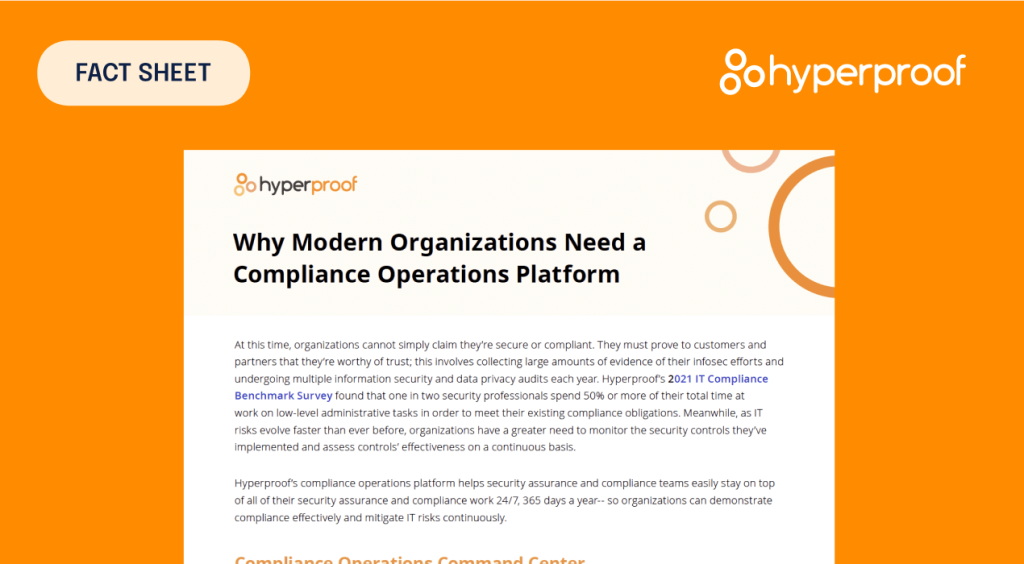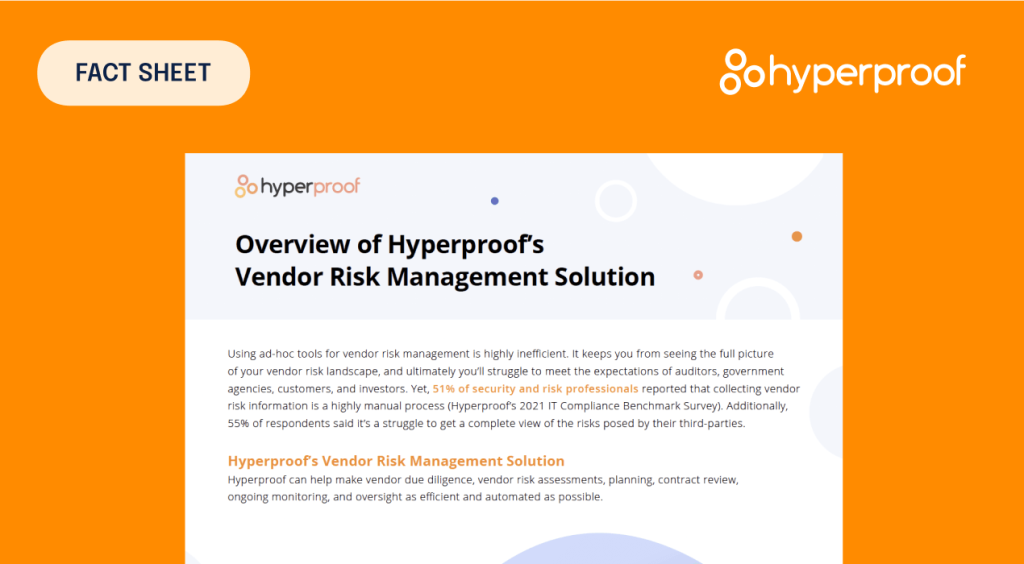Does Your Product Have the Credibility to Land Enterprise Customers?
It takes more than a great product to land enterprise-level customers. Businesses with B2B products have to demonstrate more than commercial value to convince large organizations to buy in.
Enterprise customers are extremely risk-wary. They want to know that the vendors they rely on are reliable, reputable, and compliant. It is easy to ruin a great product with bad security or unreliable support.
Hyperproof Chief Growth Officer Matt Lehto and VP of Product Alex Vorobiev hosted a webinar on Nov. 5 that showcased the changes B2B organizations can make to appeal to enterprise customers more readily.
In the virtual discussion, Lehto and Vorobiev showed how reputation, security, and compliance are three of the most important elements of the enterprise purchase decision. Vendors who focus their efforts on these three areas will present a far more attractive offer to enterprise customers.
Why reputation matters
Enterprise executives shoulder a great deal of responsibility. The decisions they make can impact the daily lives of hundreds of employees and tens of thousands of customers.
When an executive chooses a vendor, that vendor’s reputation becomes an important asset towards making the purchase decision. Enterprise-level executives understand that they will be responsible for any mistakes that the vendor makes, even if those mistakes are outside their control.
This is especially true when it comes to cybersecurity, where 82% of attacks focus on small businesses, costing an average of $200,000 per attack. Enterprise executives know that cyber attackers often target small businesses that serve large organizations, looking for entry points.
Of small businesses impacted by cyberattacks, 60% go out of business within six months. Enterprise executives do not want to be put in the position to find a new vendor after half a year and be forced to spend significant resources determining whether their systems are secure.
Compliance cultivates reputation
Many small business owners and IT leaders feel like their operations are too small to be targeted by cybercriminals. This is not the case. Even a company with very little exposure can be targeted – and many are.
Enterprise executives know this and look for vendors who can provide compliance certificates and audit results. Partners who show that they are taking steps to meet the latest security threats with proven tactics make far more reliable partners than those that do not.
In fact, 91% of large enterprises require compliance certificates or audit results from their vendors. Among medium-sized enterprises, just over half require compliance certificates or audit results from vendors.
In the past, this level of certification was often optional, especially among smaller organizations. The rise of a worldwide cybercrime industry, staffed by professionals, has changed the nature of the relationship that organizations and their partners share. Vendor scrutiny is at an all-time high and is likely to grow.
This means some company leaders simply won’t talk to potential vendors and partners who do not have certifications such as SOC 2 or ISO 27001. Security compliance certifications are crucial to top-line growth.
How to build credibility through security certification
Asking a small business with limited resources to obtain state-of-the-art security certification is not always feasible. In these cases, having a solid plan for achieving optimal security and compliance is the best you can do.
The first three practical steps that a small business owner should take in order to start their business down the path to enterprise-ready compliance are:
1. Implement the basics
You want to start with the core policies. Consider these items below homework you must complete before you begin to pursue any particular compliance certifications (e.g. SOC 2 or ISO 27001). Once you have these basics in place, you will have made significant progress towards the certifications. Here is the list of the most important policies, documents, and processes to work through:
Code of conduct/employee handbook
Every business needs to have a code of conduct that defines how a company’s staff should act on a day-to-day basis. It reflects the organization’s daily operations, core values, and overall company culture. This document should be readily available to employees and placed on the homepage of your intranet or wherever it will be easily accessible for every employee.
Information security policy
Every organization needs to have security measures and policies in place to safeguard their data. An information security policy brings together all of the policies, procedures, and technology that protect your company’s data in one document. In addition as a tool to detect and forestall information security issues (e.g. misuse of data, networks, computer systems, etc.), information security is a key part of many IT-compliance-focused frameworks (e.g. SOC 2, FEDRAMP, HIPAA). Having a detailed information security plan will put you that much closer to compliance with the frameworks that will make you a viable business partner for many organizations.
Employee onboarding and off-boarding procedures
Employees get access to many systems; proper access to systems should be enforced throughout an employees’ tenure and system privileges should be removed when an employee leaves the firm.
Privacy policy
You’re legally required to have a privacy policy, and having one in place is essential for building trust with customers.
Incentives plan
When improperly used, incentives can encourage bad behaviors (e.g. cheating to meet a sales quota) and pose a compliance risk. When doling out rewards to employees, it is important to consider not only the results they achieved but also how they achieved that result.
Communication and training: Everyone at the company, including executives, needs to know what is in their code of conduct. In addition to knowing the rules they’re expected to follow, employees also need to know who they can turn to for guidance if they have questions about compliance and how they can report violations and concerns. Outside of consistent communication about the employee code of conduct, you should also institute risk-based training for employees who work in high-risk functions and employees who implement controls.
A process for reporting misconduct
You need to empower employees to raise issues early while there’s still time to prevent bigger problems from materializing.
An incident management and response process: this guides what will get done, by whom and when, when an incident happens.
2. Have a clear plan
Being organized and making security and compliance part of your long-term plan can go a long way towards convincing enterprise customers that your organization is credible. A small organization will need to produce a certification (e.g. SOC 2, ISo 27001) sooner or later, in order to do business with a portion of its target market. To determine which specific program/certification an organization needs to obtain, it’s important to conduct customer research and hold internal conversations with key stakeholders. Gathering the following information will help a firm determine which framework(s) it needs to pursue.
- Which frameworks, standards, and certificates do you customers expect to see?
- How is data treated in your system?
- What is your go-to-market strategy?
- What are the compliance stances of key vendors and partners you work with?
Once an organization has determined the particular compliance framework/program it wants to implement, it will complete the program planning, program launch, readiness assessment, and audit stages. Each of these phases of a program is a topic all on its own. To learn more about setting up a compliance program, check out the resources on the Hyperproof website.
3. Select a designated owner
Every organization needs to have one person who oversees all security concerns. This designated owner will be your clients’ main point of contact for security and compliance.
For small businesses catering to the expectations of large enterprises, the need to implement state-of-the-art security is growing. Small business owners who think ahead and start addressing compliance issues early can enjoy a significant advantage in a crowded market.
Where does technology fit into the picture?
Cloud-based security vendors and cloud-based compliance operations software like Hyperproof lower the barrier of entry to best-in-class cybersecurity. They help organizations efficiently stand up security and compliance processes without forcing organizations to train and equip an entire security department for the purpose.
If you’d like to get more information about how to stand up a compliance program, why it’s important to do, and how Hyperproof can help.
See Hyperproof in Action
Related Resources
Ready to see
Hyperproof in action?












